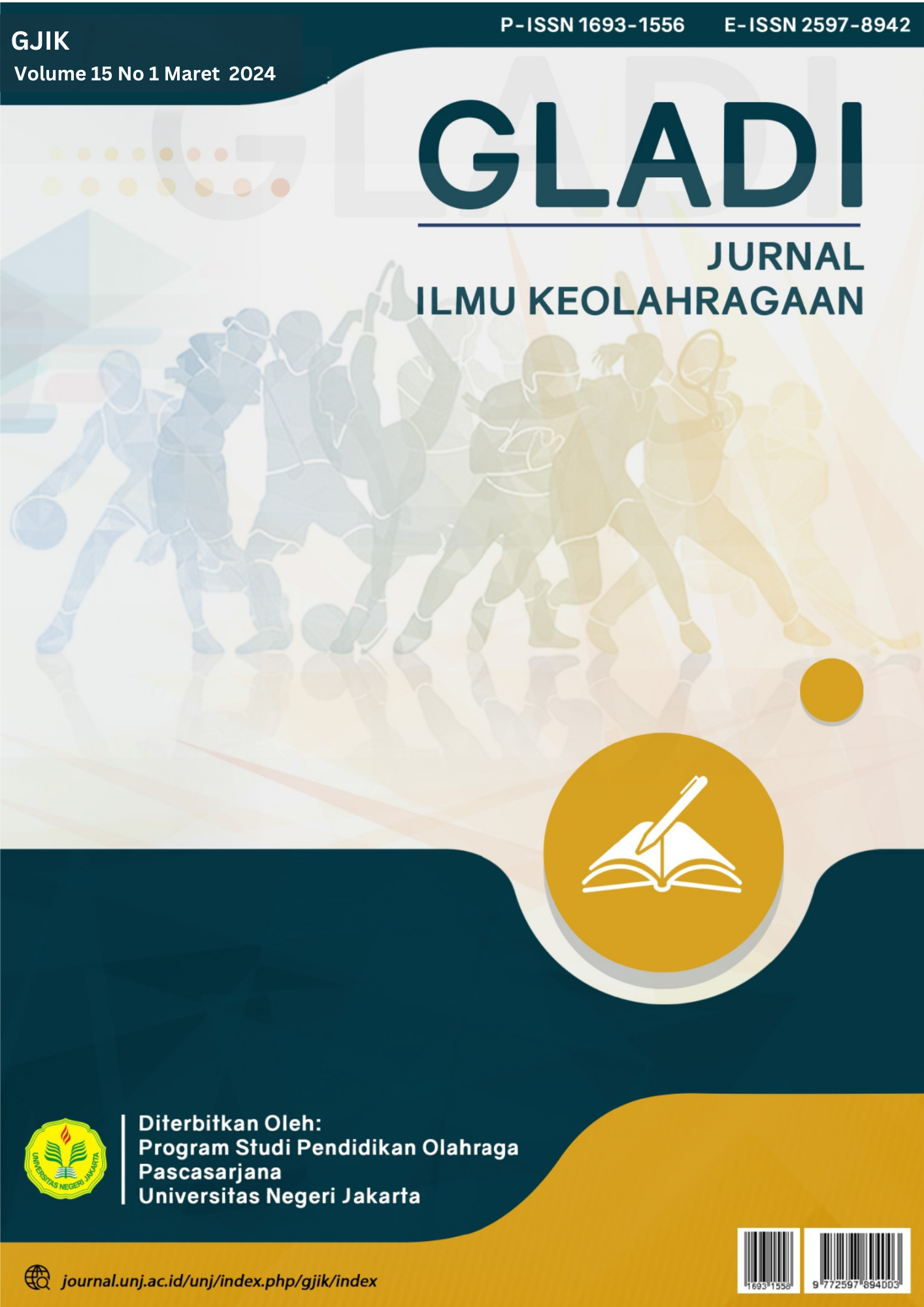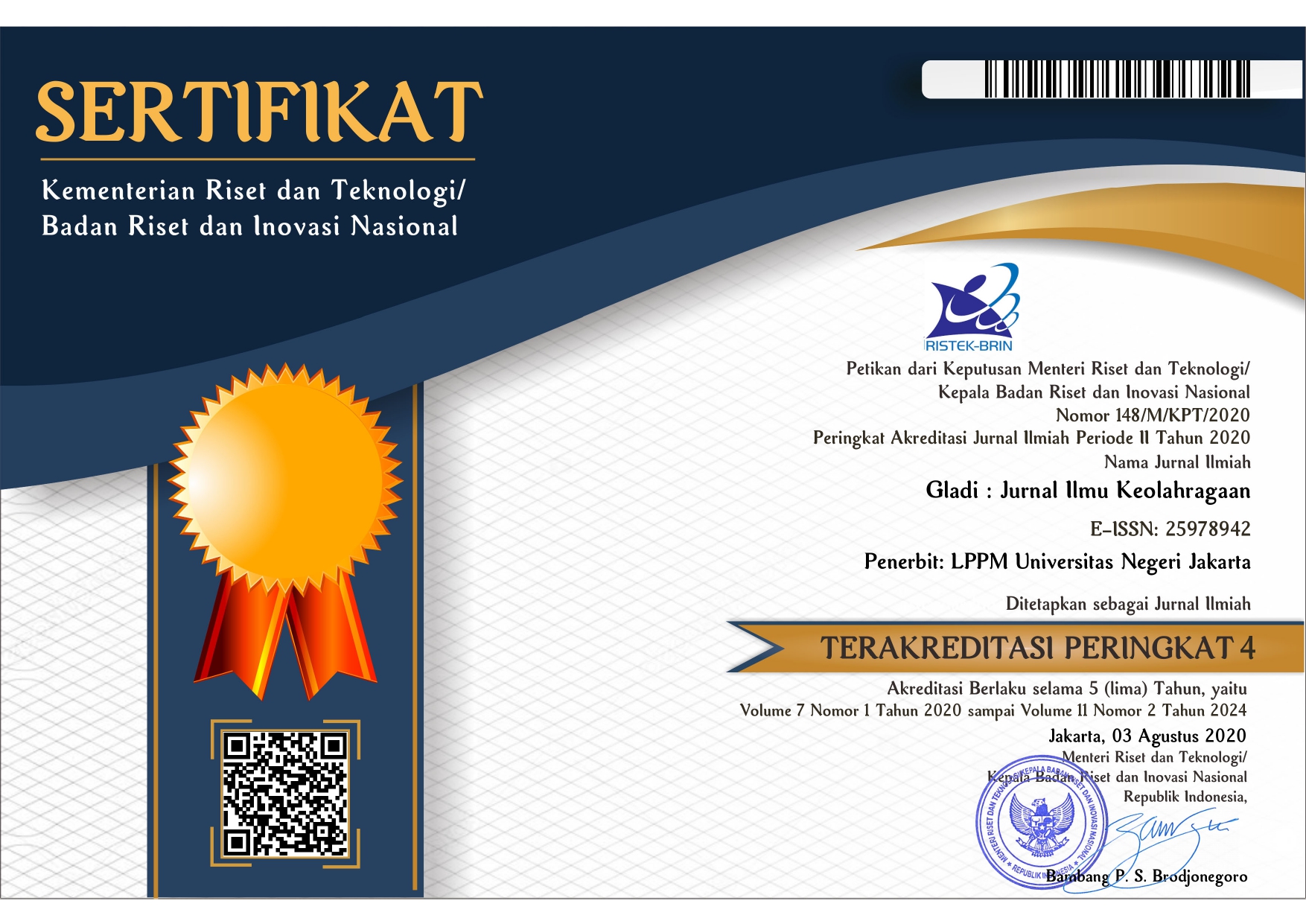THE INFLUENCE OF SPEED ENDURENCE, LEG LENGTH, AND ACHIEVEMENT MOTIVATION ON THE ACHIEVEMENT OF INDONESIAN JUNIOR TAEKWONDO ATHLETES IN 2023
DOI:
https://doi.org/10.21009/GJIK.151.08Keywords:
speed endurance; leg length; motivation; taekwondoAbstract
The purpose of this study was to determine and reveal whether or not there is an influence between speed endurance, leg length, and achievement motivation on the achievement of Indonesian taekwondo junior athletes in 2023. This research was carried out using a quantitative approach using the survey method with path analysis techniques. The population in this study were all Indonesian taekwondo junior athletes. By taking the sample using the total sampling technique where the sample used is all of the population, namely all members of Indonesian junior taekwondo athletes because in the research that will be carried out because the population is considered smaller or less than 100. Based on the results of data analysis and hypothesis testing from research data variable speed endurance, leg length, motivation and achievement results of Indonesian taekwondo junior athletes, the following conclusions can be drawn: There is an effect of speed endurance on motivation with a direct influence percentage of 49.3%. There is an effect of leg length on motivation with a direct influence percentage of 39.5%. There is an effect of speed endurance on the achievement results of Indonesian junior taekwondo athletes with a direct influence percentage of 21.3%. There is an effect of leg length on the achievement of Indonesian junior taekwondo athletes with a direct influence percentage of 19.9%. There is a motivational influence on the achievement of Indonesian junior taekwondo athletes with a direct influence percentage of 58%. There is an indirect effect between speed endurance on the achievement results of Indonesian junior taekwondo athletes through motivation with a significance value of 0.468. There is an indirect effect between leg length on the achievement of Indonesian junior taekwondo athletes through motivation with a significance value of 0.428.
Downloads
References
Azhimi, Sulastri, & Hudri, A. (2021). PENGARUH MOTIVASI DAN DISIPLIN LATIHAN TERHADAP PRESTASI ATLET TAEKWONDO DI KABUPATEN OGAN ILIR. 20(1), 13–20.
Bhattacharya, R., Shen, C., & Sambamoorthi, U. (2014). Excess risk of chronic physical conditions associated with depression and anxiety. BMC Psychiatry. https://doi.org/10.1186/1471-244X-14-10
Bing, W. C., & Kim, S. J. (2021). A phenomenological study of mental health enhancement in taekwondo training: Application of catharsis theory. International Journal of Environmental Research and Public Health. https://doi.org/10.3390/ijerph18084082
Cha, M.-H. (2021). The inherent meaning of “origin” in Taekwondo history. Journal of Martial Arts. https://doi.org/10.51223/kosoma.2021.08.15.4.81-99
Choi, C. R., Heo, C. M., Shin, M. S., & Lee, A. R. (2013). A modern history of women taekwondo in korea since the second world war. In International Journal of the History of Sport. https://doi.org/10.1080/09523367.2012.754429
Jacob, L., Oh, H., Shin, J. Il, Haro, J. M., Vancampfort, D., Stubbs, B., Jackson, S. E., Smith, L., & Koyanagi, A. (2020). Informal caregiving, chronic physical conditions, and physical multimorbidity in 48 low- And middle-income countries. Journals of Gerontology - Series A Biological Sciences and Medical Sciences. https://doi.org/10.1093/GERONA/GLAA017
Johnson, J. A. (2018). Taekwondo and peace: How a killing art became a soft diplomacy vehicle for peace. International Journal of the History of Sport. https://doi.org/10.1080/09523367.2019.1618838
José Enrique, M. G., Arroyo-Del Bosque, R., & Jiménez-Eguizábal, A. (2021). Level of physical condition and practice of physical activity in adolescent school children. Apunts. Educacion Fisica y Deportes. https://doi.org/10.5672/APUNTS.2014-0983.ES.(2021/1).143.01
Kim, H.-Y., & Choi, K.-K. (2021). A Study on the History of Children,s Taekwondo Demonstrations by Globalizing Taekwondo. Journal of Coaching Development. https://doi.org/10.47684/jcd.2021.09.23.3.22
Kim, H. B., Johnson, J. A., Lee, E. J., & Ha, P. (2016). An investigation into the history of the taekwondo uniform since the Korean Peninsula’s liberation from Japan. International Journal of the History of Sport. https://doi.org/10.1080/09523367.2016.1233865
Kim, M., Kim, M., & Kim, M. (2021). A case study on service quality perceptions and member retention towards Taekwondo participants in North America. IJASS(International Journal of Applied Sports Sciences). https://doi.org/10.24985/ijass.2021.33.2.248
Kwak, J.-H., & Yang, D.-S. (2021). Analysis of Research Trends in Taekwondo History. Korean Journal of Sports Science. https://doi.org/10.35159/kjss.2021.12.30.6.1
Lim, B. O., Kim, J., Kim, S. H., Cho, J. H., Lim, S., & Lim, S. T. (2022). The effects of taekwondo shoes on anterior cruciate ligament injury risk factors during jump whip kicks. Science and Sports. https://doi.org/10.1016/j.scispo.2021.04.002
Lu, D., Si, X., & Feng, X. (2017). The hardware implementation and signal control of sanda electronic protection devices. International Journal of Mechatronics and Applied Mechanics. https://doi.org/10.17683/ijomam.issue1.4
Maes, M., Van Den Noortgate, W., Fustolo-Gunnink, S. F., Rassart, J., Luyckx, K., & Goossens, L. (2017). Loneliness in Children and Adolescents with Chronic Physical Conditions: A Meta-Analysis. Journal of Pediatric Psychology. https://doi.org/10.1093/jpepsy/jsx046
Martínez-Martínez, J., González-Víllora, S., Valcárcel, J. V., & Pastor-Vicedo, J. C. (2020). How does the family influence the physical condition and health of children in a rural environment? International Journal of Environmental Research and Public Health. https://doi.org/10.3390/ijerph17134622
Maulana, F., & Rahman, Z. (2020). HUBUNGAN PANJANG TUNGKAI TERHADAP KECEPATAN DALAM TENDANGAN DOLLYO CHAGI PADA ATLIT TAEKWONDO KOTA SABANG. 1(1).
Moenig, U., Choi, H. M., & Kim, M. (2021). The Founder of the International Taekwon-Do Federation (ITF) Choi Hong Hi: An Exploration of Fiction and Fact. International Journal of the History of Sport. https://doi.org/10.1080/09523367.2021.1984232
Moenig, U., & Minho, K. (2016). The invention of taekwondo tradition, 1945-1972: When mythology becomes “history.” In Acta Koreana. https://doi.org/10.18399/acta.2016.19.2.006
Nugraha, S., & Ohara-Hirano, Y. (2014). Mental Health Predictor of the Sixth Batch Indonesian Nurse and Certified Care Worker Candidates Migrate to Japan under the Japan–Indonesia Economic Partnership Agreement in Pre-migration Stage. Journal of Health Science.
Rydzewska, E., Dunn, K., & Cooper, S. A. (2021). Umbrella systematic review of systematic reviews and meta-analyses on comorbid physical conditions in people with autism spectrum disorder. In British Journal of Psychiatry. https://doi.org/10.1192/bjp.2020.167
Sáez, I., Solabarrieta, J., & Rubio, I. (2020). Physical self-concept, gender, and physical condition of bizkaia university students. International Journal of Environmental Research and Public Health.







